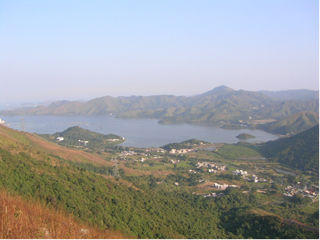Radiation Tidbits - Radiation in Our Daily Life
Radiation Tidbits - Radiation in Our Daily Life
Written by: Yeung Siu-wai
Natural radiation in the environment comes from two sources: cosmic rays and radiation present in the earth crust. Cosmic rays have already been discussed in 'Air Travel and Cosmic Radiation' . This article focuses on radiation present in the earth crust.
Naturally-occurring radiation has been part of the earth since the latter came into existence. Such primordial radiation existing in the earth crust diffuses slowly into air, water and the body of living organisms (animals and plants). As it cannot be felt or sensed by human beings, it was not until about a hundred years ago when scientists began to invent measuring instruments and discovered the existence of radiation.

Naturally-occurring radiation exists everywhere in nature
Where does radiation in the earth crust originate from?
- Radionuclide - A radionuclide is a material with an unstable atomic nucleus that spontaneously decays or disintegrates, producing radiation.
- Uranium-235 - Uranium-235 is an isotope of uranium with mass number 235. Isotopes are a group of nuclides with the same number of protons (atomic number) but different numbers of neutrons. Uranium-238 is another isotope of uranium.
What are the factors affecting the radiation level in soil?
How does natural radiation enter our body through the biosphere?
Where does the radiation in human body come from?
Where does the radiation in air come from?
Where does the indoor radon come from?
How does radon affect the human body?
How can the damage of radon to human beings be reduced?
What is the natural radiation level in Hong Kong? Is it safe? How does it compare with other places in the world?
Where can I get more information on radiation?
Natural radiation has been part of the earth since it came into existence. Primordial (i.e. since the beginning of the world) radionuclides include uranium-235, uranium-238, thorium-232, potassium-40 and neptunium-237 in rock and soil. They are unstable and undergo radioactive decay until they reach a stable state. As the decay of uranium-235, uranium-238, thorium-232 and potassium-40 is very slow, these radionuclides are still found today. Neptunium-237, on the other hand, decays fast and is no longer naturally present on earth nowadays.
Soil is formed from the erosion and ablation of rock. The speed of soil formation varies with different rock types (and the weathering processes). Therefore, the composition of natural radionuclides in soil differs in accordance with the rock type they originated from. The amount of natural radionuclides in soil and their radiation levels depend on the geologic origin, geographic location, hydrologic and climatic conditions of the soil.
Natural radiation enters the human body through three pathways. First, some natural radionuclides in the earth crust can be washed away and carried in underground water. They then enter into the human body through water intake. Secondly, the radionuclides on the soil surface can become airborne, in the form of dust or particulates, by wind action. They then enter into the human body through respiration. Thirdly, soluble radionuclides in deep soil can be absorbed by plant root and transported up the stem. The edible portion of the plant then becomes food for human or herbivore. Radiation present in the latter may eventually enter our body through ingestion.
Natural radionuclides such as radon, carbon-14, tritium, postassium-40, radium-226, polonium-210 and lead-210, are present in air, food and drinking water. These radionuclides enter the human body through inhalation and ingestion, and give off radiation when they decay. The radionuclides are absorbed during digestion, but at the same time their amounts are reduced due to decay and excretion. When the intake and excretion of radionuclides reach a balance, a stable level of radioactivity will be maintained in our body. Please also refer to question (9).
The radiation in air is mainly radon, in particular radon-222. Radon is gaseous and comes from the decay of natural radionuclides in soil. Also, when cosmic rays enter the atmosphere, radionuclides such as tritium and carbon-14 are formed. During decay, these radionuclides give off radiation in air.
There are many sources of indoor radon. The natural radioactive materials in the soil and rock of building foundation give off radon which may get indoor through cracks and joints of the building. Stone materials used in buildings and home renovations, such as rock, granite, brick and cement, also release radon. Radon in the air outdoor, though usually not at a high activity level, may go indoor through ventilation. The combustion of coal and liquid petroleum gas also releases radon.
Radon enters our body through respiration. Its decay gives off alpha particles, which results in internal exposure to our body and may cause damage to the respiratory system. Long-term exposure to alpha particles may cause damage to tissues and increase the incidence of lung cancer. Relevant guidelines exist in Hong Kong for professionals to protect building occupants from excessive radon exposure.
Avoid using construction and renovation materials with high radon level, for example granite, in building premises. Bare concrete walls and floors should be covered with wallpaper and wooden floor strips to stop infiltration of radon from the wall and floor. Always ensure adequate ventilation in the house. Do not keep windows shut over a long period to avoid accumulation of radon to an excessive level.
The unit for measuring radiation dose is milli-Sievert (abbreviated "mSv"). The annual dose received by people in the world arising from natural background radiation ranges from 1 mSv to 10 mSv. On average, the annual dose received by a member of the public in Hong Kong is about 2 mSv, which is comparable to the worlds average.
To get more information on natural occurring radiation, please visit the Observatory's webpage 'Radiation Monitoring, Assessment and Protection'.